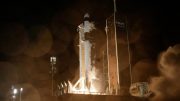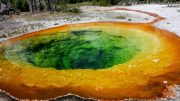Most Chinese working in the cities return to work today after a 7-day national holiday of Spring Festival. The annual Spring Festival, which is also Chinese New Year, traditionally begins with the second new moon following the winter solstice, usually in January or February. Like westerners on Thanksgiving and Christmas, people across China return to their hometown to reunite with family and friends. However, the sudden outbreak of COVID-19 last year halted the largest holiday mobilization in the world.
In response to the crisis, in late 2019, local governments launched lockdowns and behavior restrictions that reduced short-term economic and social activity. Despite the negative aspects of the pandemic, reduced human activity provided a unique opportunity for atmospheric scientists to study the impact of an unprecedented intervention on air quality.
COVID-19 lockdowns have reduced carbon dioxides, nitrogen oxides, and sulfur dioxides, all byproducts of fuel combustion used in transportation and manufacturing. These gases are closely linked to human activity, so not surprisingly, their atmospheric concentration responds quickly to economic change. Studies are showing significantly reduced airborne ammonia as well, despite the believed-to-be strong link to agricultural sources, especially in rural areas.
“We don’t think this finding is particularly surprising as the major source of ammonia in urban Beijing was found to be combustion sources rather than agricultural emissions,” says atmospheric scientist Dr. PAN Yuepeng of the Institute of Atmospheric Physics, Chinese Academy of Sciences.
Still, some researchers are startled by the substantial decrease of ammonia amid lockdowns, given that idle agricultural activities during Spring Festival holidays typically reduce ammonia levels. In an earlier study published in Advances in Atmospheric Sciences, Dr. PAN and his group tracked and corrected isotopic signatures of ammonia sources with updated active sampling. They found that that non-agricultural emissions contributed to 66% of ammonia in urban Beijing.
While debate continues regarding ammonia sources in the urban atmosphere, the lockdowns that canceled Spring Festival celebrations provided an unprecedented opportunity to check whether fossil fuel combustion is a major source of ammonia in the air within urban regions. Ideally, relatively low ammonia concentrations should be observed if vehicular emissions are reduced due to travel restrictions during the Spring Festival.
“In addition to nitrogen isotopic evidence, the new finding in lockdowns offers additional insight for the prioritization of future clean air actions on ammonia reduction,” said Dr. PAN. However, quantifying this unique scenario remains challenging as meteorological processes may mask the effective change in observed ammonia concentrations.
Pan and his collaborators introduced machine learning algorithms to models that separated these meteorological influences. They confirmed that the actual atmospheric ammonia concentration dropped to a new minimum during the 2020 Spring Festival at both urban (Beijing) and rural (Xianghe) sites. In a scenario analysis without lockdowns, ammonia concentration calculations were 39.8% and 24.6% higher than the observed values in 2020 at urban and rural sites, respectively. Their recent findings are published in Atmospheric Research.
“Future control strategies should consider the emissions of ammonia from the transportation, industrial and residential sectors, considering that agricultural emissions are minor in cold seasons.” remarked PAN.
The significant difference between the two sites indicates a larger reduction of ammonia emissions in urban areas than rural areas due to lockdown measures of COVID-19 which have reduced human activity.
References:
“Changes of ammonia concentrations in wintertime on the North China Plain from 2018 to 2020” by Yuexin He, Yuepeng Pan,
Mengna Gu, Qian Sun, Qianqian Zhang, Renjian Zhang and Yuesi Wang, 28 January 2021, Atmospheric Research.
DOI: 10.1016/j.atmosres.2021.105490
“Revisiting the Concentration Observations and Source Apportionment of Atmospheric Ammonia” by Yuepeng Pan, Mengna Gu, Yuexin He, Dianming Wu, Chunyan Liu, Linlin Song, Shili Tian, Xuemei Lü, Yang Sun, Tao Song, Wendell W. Walters, Xuejun Liu, Nicholas A. Martin, Qianqian Zhang, Yunting Fang, Valerio Ferracci and Yuesi Wang, 13 August 2020, Advances in Atmospheric Sciences.
DOI: 10.1007/s00376-020-2111-2










“COVID-19 lockdowns have reduced carbon dioxides, nitrogen oxides, and sulfur dioxides, … These gases are closely linked to human activity, so not surprisingly, their atmospheric concentration responds quickly to economic change.”
The interesting thing is that while estimates of anthropogenic CO2 emissions suggest declines of up to 18% last Spring, and about 10% for the entire year 2020, there is no measured confirmation of a change in seasonal or annual growth rate of CO2 at worldwide monitoring stations, such as Mauna Loa! That leads to some inconvenient questions.